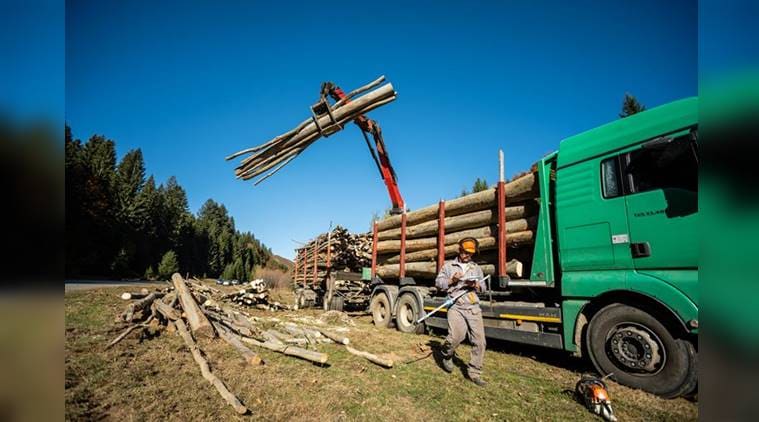 Logging out: Logged beech tree wood being stacked on to trucks to be sent to Romanian board mills from where Ikea sources. (Source: Adrian Scutariu/IKEA)
Logging out: Logged beech tree wood being stacked on to trucks to be sent to Romanian board mills from where Ikea sources. (Source: Adrian Scutariu/IKEA)
The crunch of autumn leaves under the forester’s boot on his uphill hike sounds like a mouthful of cornflakes. The marcare ciocan (marking hammer) rests against the thin beech tree, and Florin Marzac, balancing a pile of files, stands nearby talking about Romania’s forest management plan. This is in the Maramures forests in northwest Romania.
Marzac from the government-run Romsilva Maramures, the head of the Strambu-Baiut Forest District, and Ionut-Sorin Banciu, World Wildlife Fund’s regional lead for forests programme, who is breathlessly translating Romanian into English, are speaking — in different tongues — about hammers.
“These hammers are legalised by notary for a very strict use regime,” Marzac says. “All trees that have to be logged are marked with a special hammer — each with a unique code, delegated to a single person within a forest management unit.” There are 12,400-plus beech trees in the 14 hectares that make up the particular forest sub-compartment No. 173 — but the forests are being thinned. Beech, with its whiter wood, goes into making furniture for the Swedish furniture store Ikea, which opened its first Indian store in Hyderabad in August.
When a tree, 60 years old, is selected for felling, the hammer is used twice: a scratch, and then a dash of paint with a specific colour that changes every year. Then, at about a height of 1.3 m, another cut numbers the tree. It then gets measured: its diameter, species name, quality, class (whether for industrial use or firewood) all noted and filed into a central database at the Romanian environment ministry. Romanians mostly depend on firewood for heating in the winter months.
Global forestry manager Mikhail Tarasov says, Ikea has been factoring in biodiversity and climate change for over two decades and sources from Forest Stewardship Council (FSC) certified forests. The certification from FSC, an NGO which promotes responsible management of the world’s forests, “attests that the forest is being managed to preserve its natural ecosystem, and benefits the lives of locals while ensuring economic viability.”
Ikea’s aim to source all wood and paper from more sustainable sources by 2020 has been achieved last year in high-risk countries. In Maramures, a part of the income from logging is put back into the region by planting saplings for the nursery, in making better roads and for preserving water streams. Of the top 14 wood-sourcing countries, Romania is ninth with 4 per cent, while 32 per cent (or its largest chunk) comes from Poland. The global home-furnishings major consumes over 1 per cent of the world’s industrial wood, which makes up 60 per cent of its purchase value.
Since 2004, Ikea has purchased more than 33,000 hectares of forest land scattered across the southern part of Romania. The company has been embroiled in controversy for buying forestland from Harvard University, USA, which previously bought the land from people under the scanner for corruption. The company calls it a “buffer” for a “rainy day”. These are “scattered across 109 local municipalities,” says Bucharest-based Latvian Otto Zvagins, a regional wood supply and forestry manager. “Besides there are no old growth, really high-value forests,” he says, referring to Maramures, a Unesco old-growth forest.
The beech trees being logged are smaller in diameter. Some of these go to Romanian board mills from which Ikea sources. The darker, heavier, more expensive wood of India — which has been among Ikea’s top cotton-sourcing regions — does not gel well with Ikea’s Scandinavian designs. But bamboo is a good opportunity, says Tarasov, who toured India’s Northeast recently to identify suppliers and is in the process of setting up certified supply chains in Assam’s non-forest areas.
Zvagins says, “We want to sell furniture tomorrow, and the day after, if we deplete our resources, we will run into trouble. To ignore that forests also provide other benefits besides wood is very short-sighted,” he says.
The reporter visited Romania on the invitation of Ikea India.